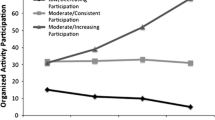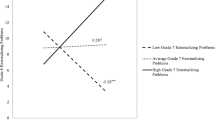Research has linked youth activity involvement to positive development. However, past studies have confounded at least two separable dimensions of involvement: breadth (number of activities) and intensity (participation frequency). Theory and the limited available evidence suggest that these dimensions may make independent contributions to development. Based on self-reports from 7430 high school students, this study assessed whether breadth and intensity dimensions were related to each other, to a typical aggregate measure of involvement, and to various indicators of positive development. Breadth and intensity were moderately interrelated and, in combination, they explained the majority of the variance in the typical involvement measure. Both dimensions were positively related to each development index. When examined simultaneously, only breadth had a unique relation with each developmental index. Further, evidence of nonlinear effects was found. Findings were consistent across age levels. Implications for measurement of involvement and interpretations of the extant research are discussed.
Similar content being viewed by others
Notes
Gender was also explored as a potential moderating variable. To do so, hierarchical regression models were tested for each developmental index entering age, gender, and parental education as predictors in step 1, breadth and intensity measures in step 2, and five nonlinear terms (breadth2, intensity2, breadth by intensity, gender by breadth, gender by intensity) in step 3. In each regression model, the interactions involving gender were nonsignificant. Similarly, results were nonsignificant when social class (using the parental education variable as a proxy indicator) was tested as a moderator instead of gender.
REFERENCES
Anderson-Butcher, D., Newsome, W. S., and Ferrari, T. M. (2003). Participation in boys and girls clubs and relationships to youth outcomes. J. Comm. Psychol. 31: 39–55.
Armsden, G. C., and Greenberg, M. T. (1987). The inventory of parent and peer attachment: Individual differences and their relationship to psychological well-being in adolescence. J. Youth Adolesc. 5: 427–453.
Baltes, P. B., Staudinger, U. M., and Lindenberger, U. (1999). Lifespan psychology: Theory and application to intellectual functioning. Annu. Rev. Psychol. 50: 471–507.
Barber, B. L., Eccles, J. S., and Stone, M. R. (2001). Whatever happened to the jock, the brain, and the princess?: Young adult pathways linked to adolescent activity involvement and social identity. J. Adolesc. Res. 16(5): 429–455.
Bartko, W. T., and Eccles, J. S. (2003). Adolescent participation in structured and unstructured activities: A person-oriented analysis. J. Youth Adolesc. 32: 233–241.
Bowker, A., Gadbois, S., and Cornock, B. (2003). Sports participation and self-esteem: Variations as a function of gender and gender role orientation. Sex Roles 49: 47–58.
Centre for Epidemiological Studies Depression Scale (CES-D). (1972), National Institute of Mental Health, USA.
Cooper, H., Valentine, J. C., Nye, B., and Lindsay, J. J. (1999). Relationships between five after-school activities and academic achievement. J. Educ. Psychol. 91: 369–378.
Côté, J. (1999). The influence of the family in the development of talent in sport. Sport Psychol. 13: 395–417.
Damon, W. (2004). What is positive youth development? Ann. Am. Acad. Pol. Soc. Sci. 591: 25–39.
Diener, E., Larson, R. J., Levine, S., and Emmons, R. A. (1985). Intensity and frequency: The underlying dimensions of positive and negative affect. J. Pers. Soc. Psychol. 48: 1253–1265.
Eccles, J. S., and Barber, B. L. (1999). Student council, volunteering, basketball, or marching band: What kind of extracurricular involvement matters? J. Adolesc. Res. 14: 10–43.
Eccles, J. S., Barber, B. L., Stone, M., and Hunt, J. (2003). Extracurricular activities and adolescent development. J. Soc. Issues 59: 865–889.
Erikson, E. (1968). Identity, Youth, and Crisis, Norton, NY.
Fletcher, A. C., Nickerson, P., and Wright, K. L. (2003). Structured leisure activities in middle childhood: Links to well-being. J. Comm. Psychol. 31: 641–659.
Fletcher, A. C., and Shaw, R. A. (2000). Sex differences in associations between parental behaviors and characteristics and adolescent social integration. Soc. Dev. 9: 133–148.
Gauze, C., Bukowski, W. M., Aquan-Asse, J., and Sippola, L. K. (1996). Interactions between family environment and friendship and associations with self perceived well-being during early adolescence. Child Dev. 67: 2201–2216.
Gerber, S. B. (1996). Extracurricular activities and academic achievement. J. Res. Dev. Educ. 30: 42–50.
Ginsburg, G., LaGreca, A., and Silverman, W. (1998). Social anxiety in children with anxiety disorders: Relation with social and emotional functioning. J. Abnorm. Child Psychol. 26: 175–185.
Hamilton, S., and Fenzel, L. (1988). The impact of volunteer experience on adolescent social development: Evidence of program effects. J. Adolesc. Res. 3: 65–80.
Hansen, D. M., Larson, R. W., and Dworkin, J. B. (2003). What adolescents learn in organized youth activities: A survey of self-reported developmental experiences. J. Res. Adolesc. 13: 25–35.
Hart, D., and Fegley, S. (1996). Prosocial behavior and caring in adolescence: Relations to self-understanding and social judgment. Child Dev. 66: 1346–1359.
Iso-Ahola, S. (1980). The Social Psychology of Leisure and Recreation, W. Brown, Dubuque, IA.
Jacobs, J. E., Vernon, M. K., and Eccles, J. (2005). Activity choices in middle childhood: The roles of gender, self-beliefs, and parents’ influence. In Mahoney, J. L., and Larson, R. W. (eds.), Organized Activities as Contexts of Development: Extracurricular Activities, After-School and Community Programs, Erlbaum Associates, Mahwah, NJ, US, pp. 235–254.
Johnson, M. K., Beebe, T., Mortimer, J. T., and Snyder, M. (1998).Volunteerism in adolescence: A process perspective. J. Res. Adolesc. 8: 309–332.
Kelly, E. A., Glover, J. A., Keefe, J. W., Halderson, C., Sorenson, C., and Speth, C. (1996). National Association of Secondary School Principals School Climate Survey—Form A. Contact information: 1904 Association Drive., Reston, Virginia, 22091. United States.
Larson, R. (2000). Toward a psychology of positive youth development. Am. Psychol. 55: 170–183.
Luthar, S. S. (2003). Resilience and Vulnerability: Adaptation in the Context of Childhood Adversities, Cambridge University Press, New York.
Luthar, S. S., and Becker, B. E. (2002). Privileged but pressured? A study of affluent youth. Child Dev. 73: 1593–1610.
Luthar, S. S., and D’Avanzo, K. (1999). Contextual factors in substance use: A study of suburban and inner-city adolescents. Dev. Psychopathol. 11: 845–867.
Loy, D. P., Dattilo, J., and Kleiber, D. A. (2003). Exploring the influence of leisure on adjustment: Development of the leisure and spinal cord injury adjustment model. Leisure Sci. 25: 231–255.
Mahoney, J. L. (2000). School extracurricular activity participation as a moderator in the development of antisocial patterns. Child Dev. 71: 502–516.
Mahoney, J. L., Cairns, B. D., and Farmer, T. W. (2003). Promoting interpersonal competence and educational success through extracurricular activity participation. J. Educ. Psychol. 95: 409–418.
Mahoney, J. L., Eccles, J. S., and Larson, R. W. (2004a). Processes of adjustment in organized out-of-school activities: Opportunities and risks. New Direct. Youth Dev. 101: 115–144.
Mahoney, J. L., Schweder, A. E., and Stattin, H. (2002). Structured after-school activities as a moderator of depressed mood for adolescents with detached relations to their parents. J. Comm. Psychol. 30: 69–86.
Mahoney, J. L., and Stattin, H. (2000). Leisure activities and adolescent antisocial behavior: The role of structure and social context. J. Adolesc. 23: 113–127.
Mahoney, J. L, Stattin, H., and Lord, H. (2004b). Unstructured youth recreation centre participation and antisocial behavior development: Selection influences and the moderating role of antisocial peers. Int. J. Behav. Dev. 28: 553–560.
Marica, J. (1966). Development and validation of ego identity status. J. Pers. Soc. Psychol. 3: 551–558.
Marini, Z., Spear, S., and Bombay, K. (1999). Peer victimization in middle childhood: Characteristics, causes, and consequences of bullying. Brock Educ. 9: 32–47.
McHale, S. M., Crouter, A. C., and Tucker, C. J. (2001). Free-time activities in middle childhood: Links with adjustment in early adolescence. Child Dev. 72: 1764–1778.
McMahon, S. D., Singh, J. A., Garner, L. S., and Benhorn, S. (2004). Taking advantage of opportunities: Community involvement, well-being, and urban youth. J. Adolesc. Health 34: 262–265.
McNeal, R. B. (1995). Extracurricular activities and high school dropouts. Sociol. Educ. 68: 62–81.
Oman, R. F., Vesely, S. K., McLeroy, K. R., Harris-Wyatt, V., Aspy, C., Rodine, S., and Marshall, L. (2002). Reliability and validity of the Youth Asset Survey (YAS). J. Adolesc. Health 31: 247–255.
Powell, D. R., Peet, S. H., and Peet, C. E. (2002). Low income children’s academic achievement and participation in out-of-school activities in 1st grade. J. Res. Childhood Educ. 16: 202–211.
Pratt, M. W., Skoe, E. E., and Arnold, M. L. (2004). Care reasoning development and family socialisation patterns in later adolescence: A longitudinal analysis. Int. J. Behav. Dev. 28: 139–147.
Richman, E. L., and Shaffer, D. R. (2000). If you let me play sports … How might sports participation influence the self-esteem of adolescent females? Psychol. Women Q. 24: 189–199.
Rosenberg, M. (1965). Society and the Adolescent Self Image, Princeton University Press, Princeton, NJ.
Schafer, J. L., and Graham, J. W. (2002). Missing data: Our view of the state of the art. Psychol. Methods 7: 147–177.
Schimmack, U., and Diener, E. (1997). Affect intensity: Separating intensity and frequency in repeatedly measured affect. J. Pers. Soc. Psychol. 73: 1313–1329.
Shanahan, M. J., and Flaherty, B. P. (2001). Dynamic patterns of time use in adolescence. Child Dev. 72: 385–401.
Smoll, F. L., Smith, R. E., Barnett, N. P., and Everett, J. L. (1993). Enhancement of children’s self-esteem through social support training for youth sport coaches. J. Appl. Psychol. 78: 602–610.
Statistics Canada (2001). Population by ethnic origin [on-line]. Available: www12.statcan.ca.
Stephen, J., Fraser, E., and Marcia, J. E. (1992). Moratorium-achievement (Mama) cycles in lifespan development: Value orientations and reasoning system correlates. J. Adolesc. 15: 283–230.
Willoughby, T., Chalmers, H., and Busseri, M. A. (2004). Where is the syndrome? Examining co-occurrence among multiple adolescent problem behaviors. J. Consult. Clin. Psychol. 72: 1022–1037.
Yates, M., and Youniss, J. (1996). A developmental perspective on community service in adolescence. Soc. Dev. 5: 85–111.
Youniss, J., McLellan, J. A., Su, Y., and Yates, M. (1999). The role of community service in identity development: Normative, unconventional and deviant orientations. J. Adolesc. Res. 14: 248–261.
Youniss, J., Yates, M., and Su, Y. (1997). Social integration: Community service and marijuana use in high school seniors. J. Adolesc. Res. 12: 245–262.
ACKNOWLEDGMENTS
This research was supported by grants from the Social Sciences and Humanities Research Council of Canada, Human Resources Development Canada, and the Health Canada Centre of Excellence for Youth Engagement Program (The opinions expressed in this manuscript do not necessarily reflect those of the funding agencies). We thank participating schools and students for their contribution to this research.
Author information
Authors and Affiliations
Corresponding author
Rights and permissions
About this article
Cite this article
Rose-Krasnor, L., Busseri, M.A., Willoughby, T. et al. Breadth and Intensity of Youth Activity Involvement as Contexts for Positive Development. J Youth Adolescence 35, 365–379 (2006). https://doi.org/10.1007/s10964-006-9037-6
Received:
Accepted:
Published:
Issue Date:
DOI: https://doi.org/10.1007/s10964-006-9037-6




